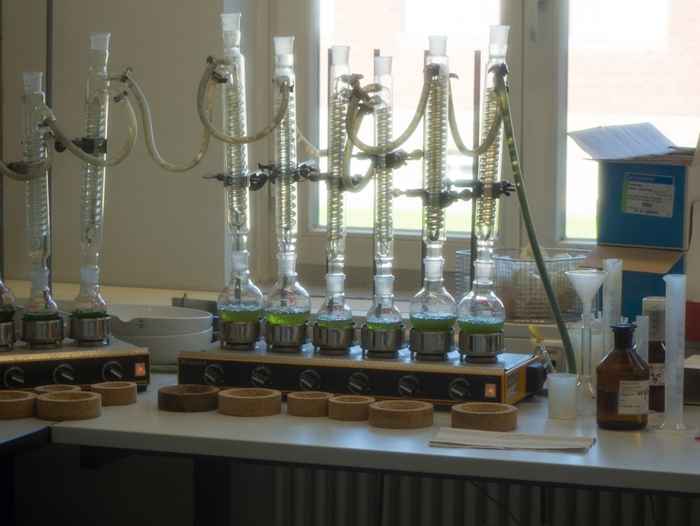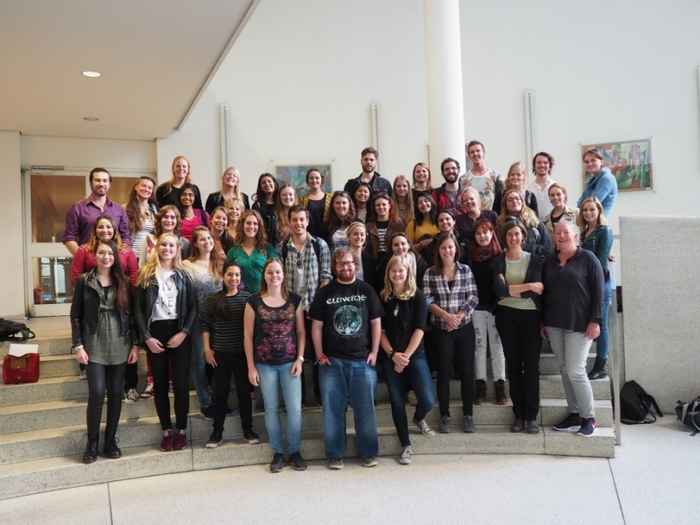Study trip 2015: Berlin
Written by: Jessie Poelsma, first-year student Forensic Science 2015
Institut für Rechtsmedizin (Münster)
The Institut für Rechtsmedizin has two main investigative disciplines. The discipline of forensic DNA-analysis, dealing with the identification of people, animals and plants, and next to that the discipline of toxicology, dealing with the analysis of intoxications. Currently they are for example working on research concerning cannabis paternity (from which plant or which plant species did this sample originate?). Besides research projects, they also do investigations for forensic cases. For example, analysing 400 latex gloves, swabbing all of them to collect possible DNA samples. The discipline of toxicology deals with investigations like date rape drugs (in the broadest sense) and the analysis of confiscated street drugs. They also perform alcohol tests on blood samples for the traffic police. Here’s a tip for visitors of Münster: when you’re drunk, you’d better take the car instead of a bike. The police checks on bikers more often than on cars, and you can lose your driver’s license when you’re riding a bike and blow more than 1,6 ppm.

Leibniz Institut für Zoo- und Wildlifeforschung (Berlin)
At the Leibniz Institut für Zoo- und Wildlifeforschung, they combine the science of wildlife biology with the science of forensics. In this way they can investigate wildlife crime, which they define in the broadest sense. They investigate non-human biological evidence, illegal taking and poaching, possession of illegal wildlife and wildlife artifacts, trading, shipping and moving, and the cruelty to or persecution of wildlife. The immediate thoughts that came to our minds was that they investigate ivory and tiger skins. They actually do so, but they also investigate – for example – illegal logging of timber, fraud with horse meat, and if sheep are attacked by a wolf or a dog (which has implications for the insurance, since dogs are domestic animals and wolves are not). Where human forensics deals with only one species, wildlife forensics deal with multiple species. Therefore, they run into several problems: almost nothing is standardized, there are almost no known statistical probabilities, and for the human genome it is known if new markers need to be developed, whereas this is unknown for animal species. In short: there is still a lot to be discovered in this field!
Landeskriminalamt (Berlin)
The Landeskriminalamt (or LKA) can be described as a State Criminal Police Office. LKAs are part of the state police focusing on all sorts of forensic investigations. We were given a presentation on ‘crimes against people’. They told us how they do their research on several (possible) traces, and how that may contribute to getting a lead in the research, or even identifying and finding a suspect. For example, they can trace back to a suspect because of certain clothes that they wore when they were recorded on a video camera. They do this by identifying patterns on clothes (one spot from an army pattern on a retrieved sweater may or may not coincide with the spot on the sweater of a suspect), checking for signs of wear and tear on clothes and shoes (the folds and creases in the fabric, lighter spots, seams, etcetera), and by taking photographs with several different filters to distinguish otherwise indistinguishable stains on clothing. In this way, they keep their city safe. Berlin, the city that never sleeps…

Berlin
Luckily, there was also time to explore the city itself, with all of its cultural aspects. Some students were happily moving from the Berlin Wall with Checkpoint Charlie to the Brandenburger Tor, and from the Berlin Cathedral back to the Jewish memorial site. Others were going to less prominent places, like the Ritter Sport store where you can make your own chocolate, and a park where the music of a festival, organized for the Day of National Solidarity, could be enjoyed together with a traditional ‘Bratwurst’.
It is 7.15 AM, and still dark. Everyone is tired of waking up really early. But who cares? We’re going on a study trip to Münster and Berlin with our fellow students!